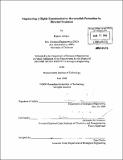Engineering a highly enantioselective horseradish peroxidase by directed evolution
Author(s)
Antipov, Eugene
DownloadFull printable version (8.588Mb)
Alternative title
Engineering a highly enantioselective HRP by directed evolution
Other Contributors
Massachusetts Institute of Technology. Dept. of Biological Engineering.
Advisor
Alexander M. Klibanov.
Terms of use
Metadata
Show full item recordAbstract
There is an ever-growing demand for enantiopure chemical compounds, particularly new pharmaceuticals. Enzymes, as natural biocatalysts, possess many appealing properties as robust asymmetric catalysts for synthetic chemistry. However, their enantioselectivity toward most synthetically useful, non-natural substrates is typically low. Therefore, improving enzymatic enantioselectivity toward a given substrate is a practically important but arduous task. Here we report a highly efficient selection method for enhanced enzymatic enantioselectivity based on yeast surface display and fluorescenceactivated cell sorting (FACS). By exploiting the aforementioned method, in just three rounds of directed evolution we both greatly increased (up to 30-fold) and also reversed (up to 70-fold) the enantioselectivity of the commercially useful enzyme, horseradish peroxidase (HRP), toward a chiral phenol. In doing so, we discovered that mutations close to the active site not only preserve HRP catalytic activity but impact its enantioselectivity far greater than distal mutations. We thus examined how a single mutation near the active site (Argl78Glu) greatly enhances (by 25-fold) the enantioselectivity of yeast surface-bound HRP. Using kinetic analysis of enzymatic oxidation of various substrate analogs and molecular modeling of enzyme-substrate complexes, this enantioselectivity enhancement was attributed to changes in the transition state energy due to electrostatic repulsion between the carboxylates of the enzyme's Glu- 178 and the substrate's D enantiomer. In addition, the effect of yeast surface immobilization and influence of a fluorescent dye on controlling the enantioselectivity of the discovered HRP variants was investigated. Soluble variants were also shown to have marked improvements in enantioselectivity, which were rationalized by computational docking studies.
Description
Thesis (Ph. D.)--Massachusetts Institute of Technology, Dept. of Biological Engineering, 2009. Cataloged from PDF version of thesis. Includes bibliographical references.
Date issued
2009Department
Massachusetts Institute of Technology. Department of Biological EngineeringPublisher
Massachusetts Institute of Technology
Keywords
Biological Engineering.